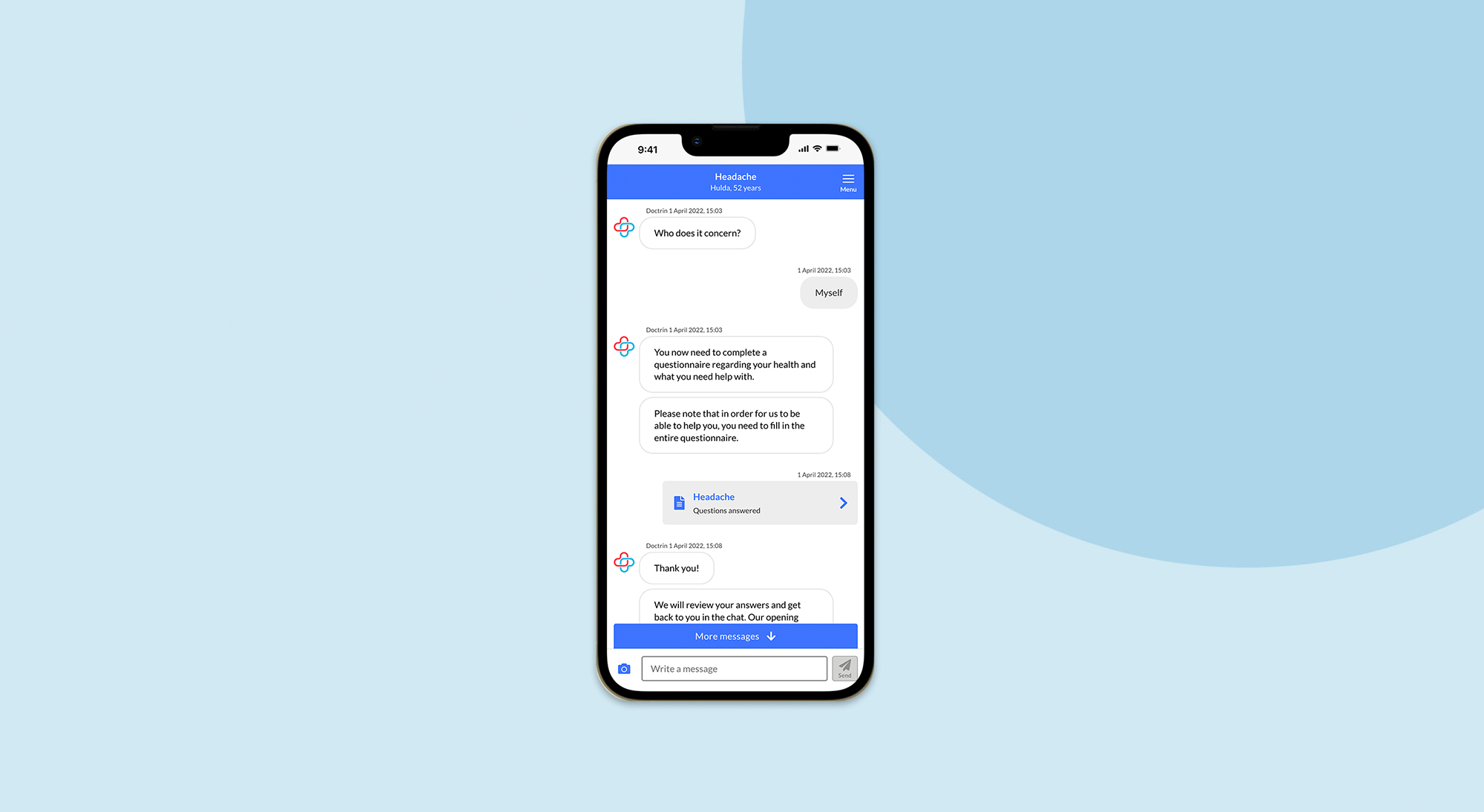
User manual
How to use Doctrin
1. Summary
This is the complete user manual for patients using Doctrin Source (v. 1.0.X).
User manual Version 1.2
Updated: 03/04/2025
Copyright © 2024 Doctrin AB
The instructions for use can be found online at https://doctrin.se/ifu-user-manual/. A paper copy of the instructions for use can be sent to you free of charge. Contact Doctrin with your request.
Symbols
 |
Manufacturer |
 |
Consult instructions for use |
 |
Catalogue Number |
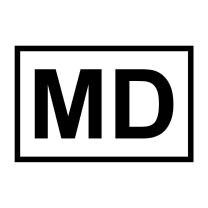 |
Medical Device |
 |
Date of manufacture |
 |
Unique Device Identifier |
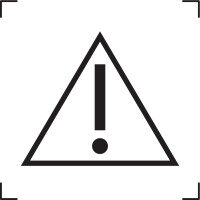 |
Caution |
 |
Warning |
2. Introduction to the product
Doctrin Source is a software medical device. It asks questions about your health and summarises your answers in a medical history report. Both you and the healthcare staff can see the report. Doctrin Source does not carry out diagnostics or treatment. The product is not intended for use in critical medical conditions.
Doctrin Source is a white label product and is usually integrated into healthcare organisations’ own digital means of contact and interfaces via, for example, apps and websites.
Please note that Doctrin AB is not a caregiver. Doctrin AB supplies software products that are used by actors in the healthcare sector.
Limitations in the use of the product
The product requires you to be able to process information and interact with it digitally. If you have cognitive or physical difficulties where assistive tools are not sufficient, there are alternative ways to provide information, such as speaking with healthcare professionals.
3. Warnings and precautions
The product is not intended to be used for critical medical conditions.
If you have any of the symptoms below or are worried that you have a life-threatening condition, you should instead call 999. If you are worried about an urgent medical concern, visit www.111.nhs.uk or call 111 to speak to a fully trained adviser. The product should not be used to seek care for someone who cannot communicate their symptoms, for example a person who is unconscious or who for other reasons cannot express themselves.
If you have any of the symptoms below or are worried that you have a life-threatening condition, you should instead call 999. If you are worried about an urgent medical concern, visit www.111.nhs.uk or call 111 to speak to a fully trained adviser.

3. 1 Examples of symptoms that could be life-threatening
- signs of heart attack
chest pain, pressure, heaviness, tightness or squeezing across the chest
- signs of stroke
face drooping on one side, cannot hold both arms up, difficulty speaking
- sudden confusion (delirium)
cannot be sure of own name or age
- suicide attempt
by taking something or self-harming
- severe difficulty breathing
not being able to get words out, choking or gasping
- heavy bleeding
spraying, pouring or enough to make a puddle
- severe injuries
after a serious accident
- seizure (fit)
shaking or jerking because of a fit, or unconscious (cannot be woken up)
- sudden, rapid swelling
of the lips, mouth, throat or tongue
- labour or childbirth
water breaking, more frequent intense cramps (contractions), baby coming or just born
- weakness or paralysis

3.2 Examples of other symptoms that may need urgent treatment
Some symptoms may require urgent treatment, even though they are not perceived as life-threatening. If you have any of the symptoms below, you may need urgent treatment and should not wait several hours for a digital first assessment of your questionnaire.
- altered sensation, such as numbness, tingling or pricking
- sudden change in vision, such as blurred vision, loss of vision or light / dots in the field of vision
- Problems with urination or defecation without an identifiable cause
- vomiting without other symptoms
- very severe abdominal pain
- very severe headache, especially if it came on suddenly
- Severe swelling without an identifiable cause
- prolonged fever
- unexplained, very severe feeling of fatigue
- sudden or severe shortness of breath without an identifiable cause
- very severe back pain
- pain in the scrotum
- strong skin reaction in connection with drug treatment or food, even if you do not have a known allergy
If you are not sure whether your symptom is urgent, you can call the healthcare advice line.
4. How to use the product
You can use the product if you want to seek care digitally, or if a caregiver has sent you a questionnaire.
The product can also be used for a child who needs care –if an adult relative can fill in the questionnaire for the child. The questionnaire can be filled in on a mobile phone, computer or tablet.

4.1. Start a contact with a practice
-
When you start a contact, you will first be asked to verify your identity. This may, for example, require an NHS login.
-
After you have verified your identity, you can start a case . When contact is initiated, you will be asked to read and accept a Privacy Notice.
-
When you accept the Privacy Notice, you can select who you are seeking care for: yourself or a child.
-
As the next step, you are asked to select your reason for contact. If you have multiple symptoms, select the questionnaire that best matches your main problem. You will get the opportunity to describe more symptoms in the questionnaire.
If you are unsure or can not find a questionnaire that match the reason why you are seeking care, you can select a questionnaire that starts with “Other”, or one that best matches your reason. If you select a reason that is not completely accurate, describe with details what you seek care for. The reason you give will be the base for the questions you receive.

4.2. When your practice contacts you with questions to answer
Your practice can contact you and ask you to answer a questionnaire. This could, for example, be prior to a visit or as a follow-up after your visit.
When this happens, the healthcare staff will assess which questions they need answers to in order to help you in the best way.

4.3. Answer questionnaires
The questionnaire shows you one question at a time. Answer the question and select ‘Next’ to save your answer and move on to the next question. Some questions are possible to skip, use this option when you’re not sure what to answer. Click ‘Previous’ to go back to the previously asked question.
Your answers will be saved as you complete the questionnaire. You can log out and log back in if you need to take a break. A partially completed questionnaire is saved for a limited time. Ask your caregiver if you are unsure how much time you have to answer the questions. The default setting is that questionnaires are saved for 7 days from the time they are started.
There are different types of question formats in the questionnaire:
- Answer with free text
- Answer with multiple options
- Answer with date (calendar)
- Answer with numbers
- Answer with a scale
Below are screenshots of the different types of questions and tips for what to consider when answering them.
1. Answer with free text
If the question is followed by a textfield, the answer must be given in free text. You will normally be asked to describe something, for example your reason for contact or a particular problem.
The free text answers help the healthcare staff to gather a more comprehensive understanding of you and your health. Here are some tips for what to consider when you get questions about:
- Why you want to contact the practice: briefly describe your symptoms, your health or any other reason for contact. It is a good idea to compare your perceived health now with how you usually feel, and what is different.
- What you expect from the contact: write what you hope the contact will lead to or what kind of help you think you need.
- A particular symptom: Describe how you experience the symptom as best you can. It is a good idea to compare how you normally feel, and specify if the symptom restricts your everyday life in any way.
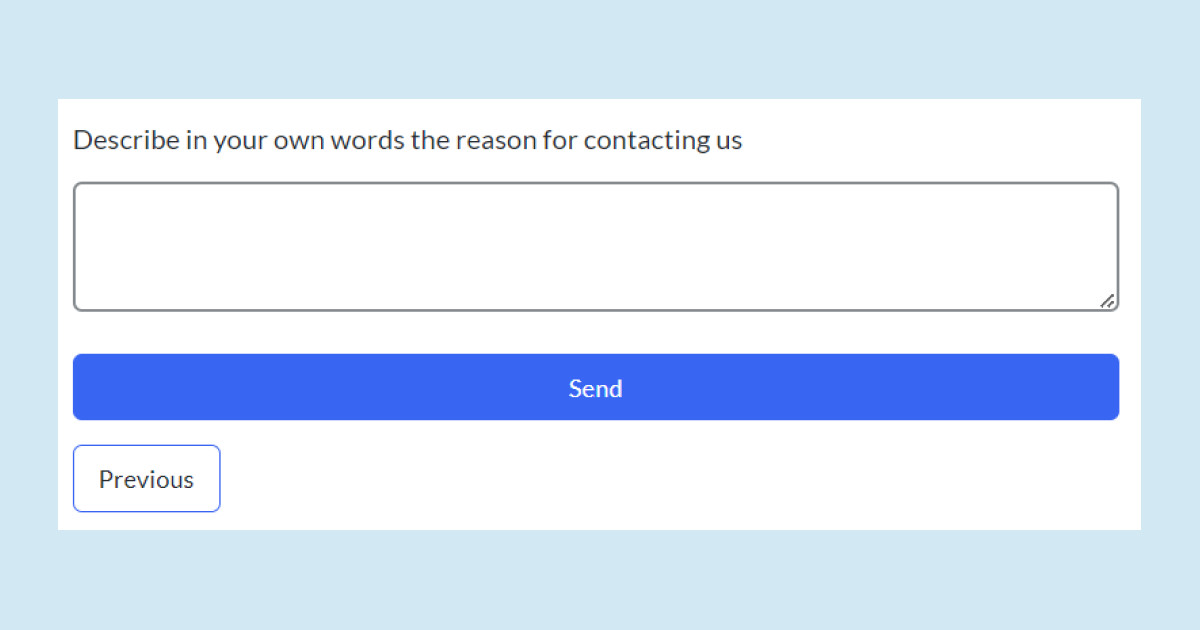
2. Answer with multiple options
If the question is followed by multiple options, the answer must be given by selecting the option that is right for you.
You will normally be asked to enter if you have any other symptoms that may be relevant to the healthcare staff’s assessment.
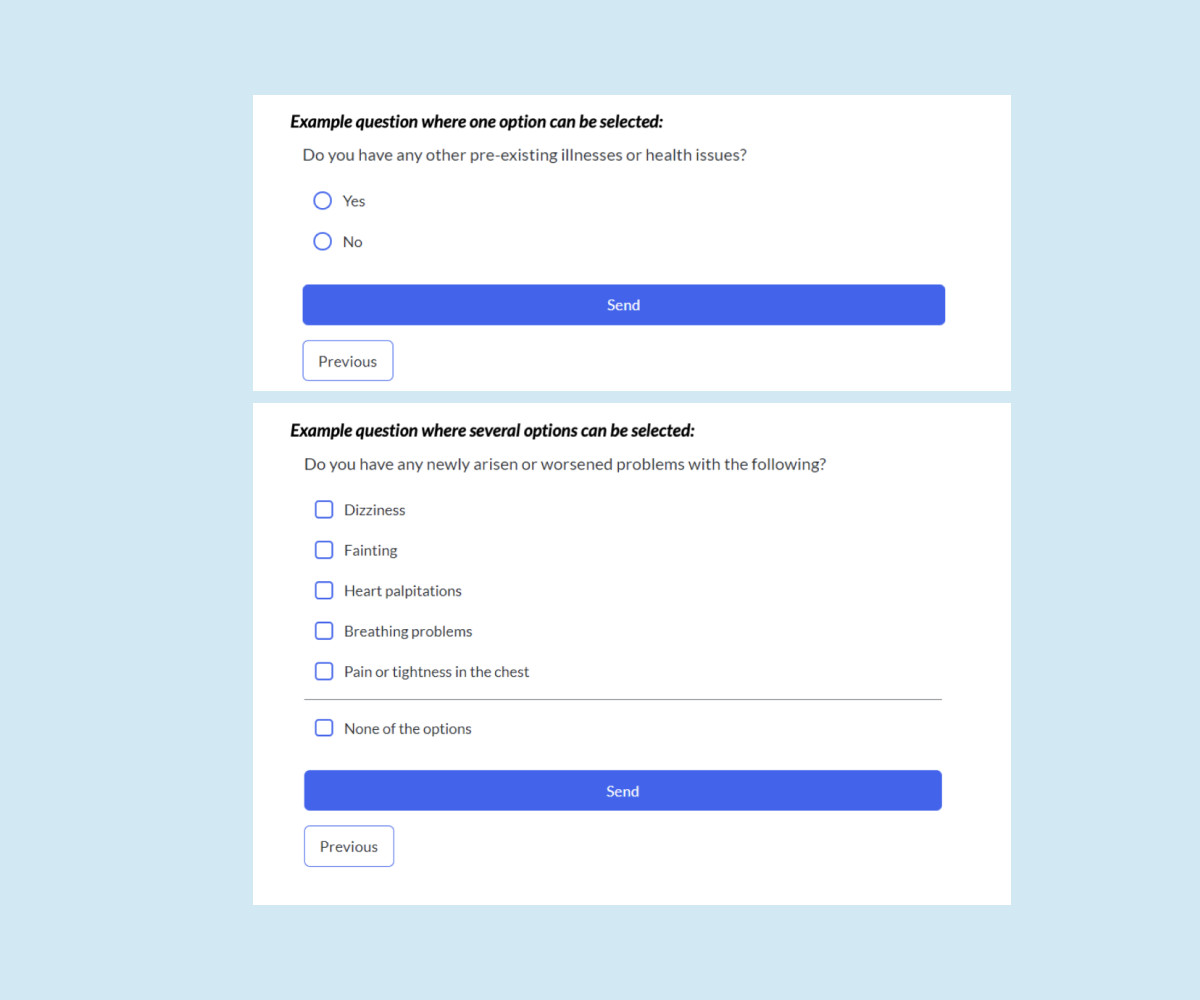
3. Answer with date (calendar)
If the question is followed by a textfield with the text ‘Enter the date’, you are expected to answer with a date. Click on the textfield to select your answer.
You can select your answer from the calendar or enter a date in the field with numbers. The accepted date format is DD/MM/YYYY (day-month-year).
Answer as best you can or skip the question if you don’t remember the exact date. Inform the healthcare staff in the chat if you know that the date might not be quite right.
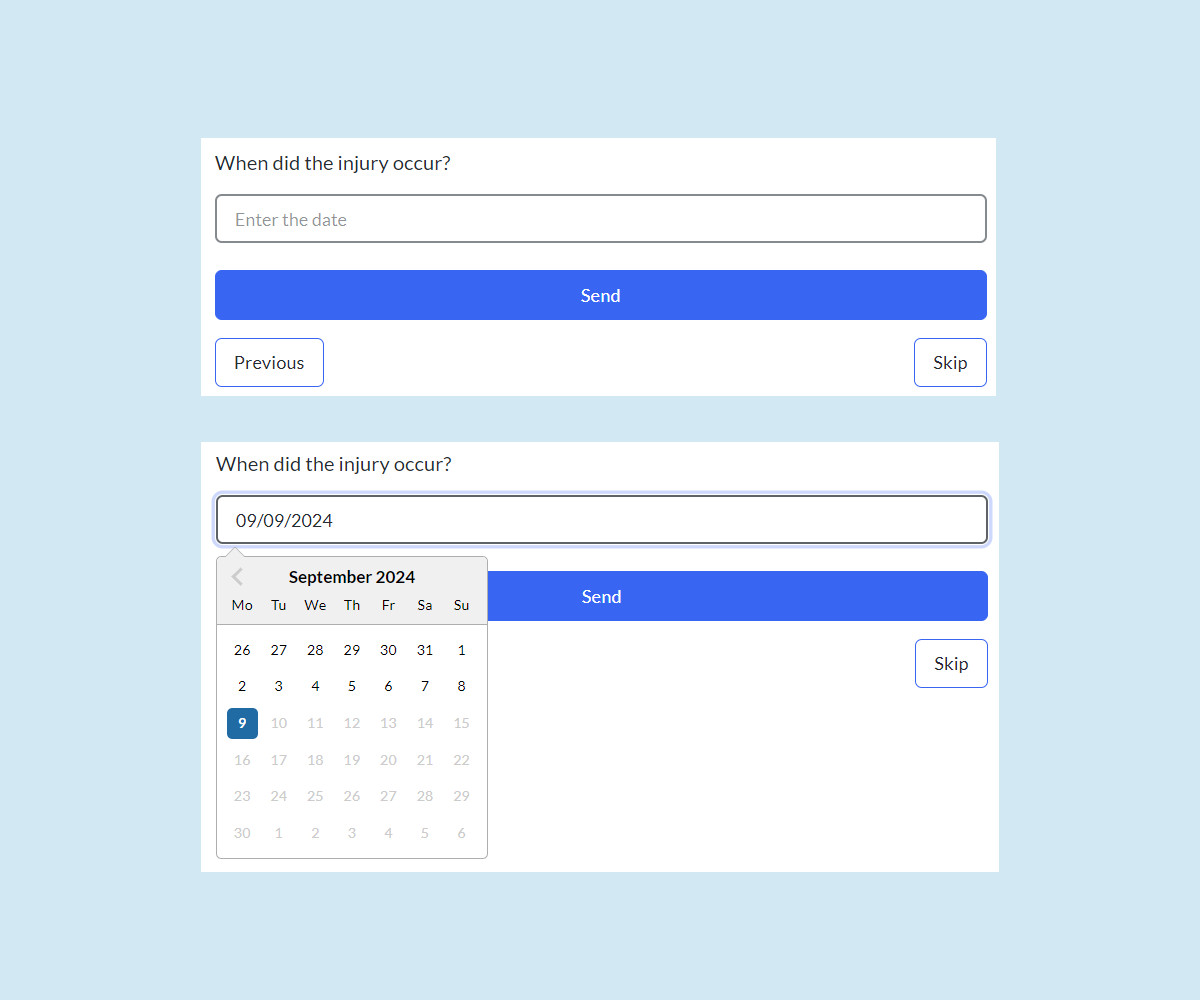
4. Answer with numbers
If the question is followed by a smaller field, the answer must be given in numbers. You will normally be asked to enter a value, how often or how long ago something happened. Read the question carefully before answering. Skip the question or answer as best you can if you are unsure of your answer.
Inform the healthcare staff in the chat if you know that the answer might not be quite right.
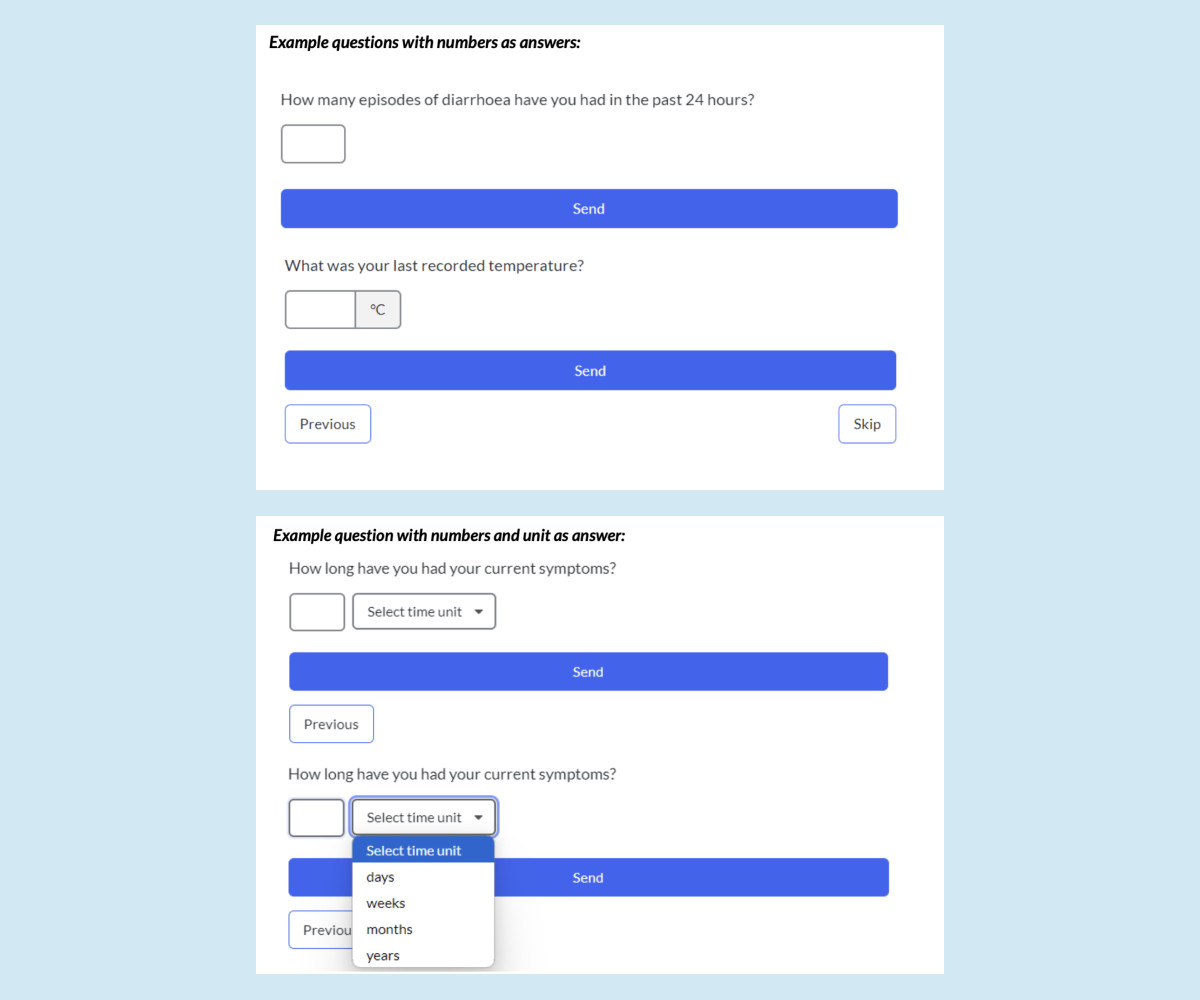
5. Answer with a scale
If the question includes a scale with numbers, answer by selecting the number that is right for you. Read what the numbers mean by looking at the text at each end of the scale.
You are expected to answer based on your own experience. You have the opportunity to describe your symptoms in your own words in free text questions or directly in the chat. Please use the free text questions to mention if you are feeling considerably worse.
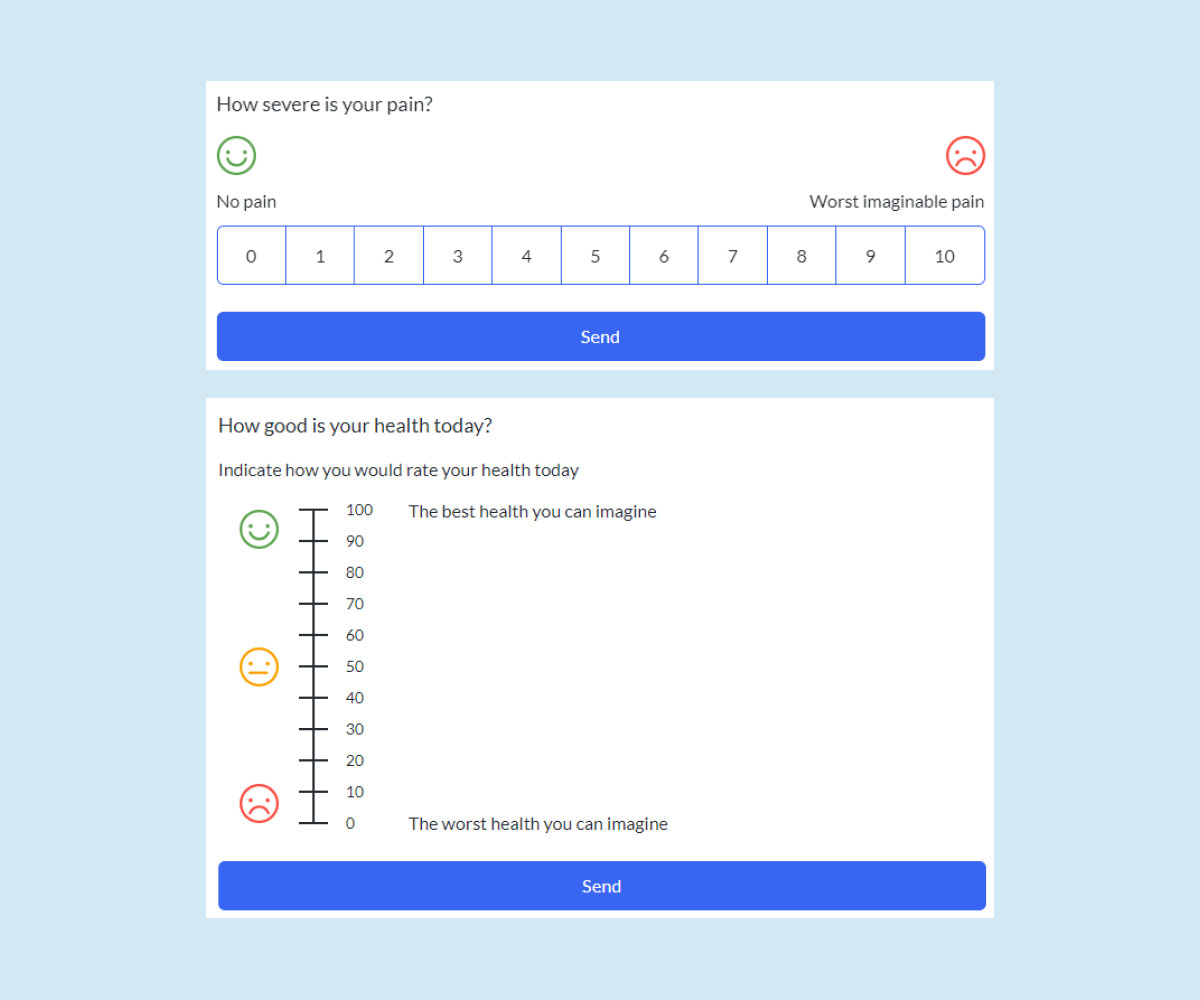
4.4.When you have completed a questionnaire
When you have completed a questionnaire, you will be taken to a chat where healthcare staff will welcome you.
If you are unsure when the chat is staffed and what response time to expect, you can read the automatic chat messages that inform you about the chat’s opening hours.
Take part in the medical history report
Your answers from the questionnaire are gathered into a medical history report that both you and the healthcare staff can read. Open the medical history report by clicking on the name of the questionnaire in the chat.
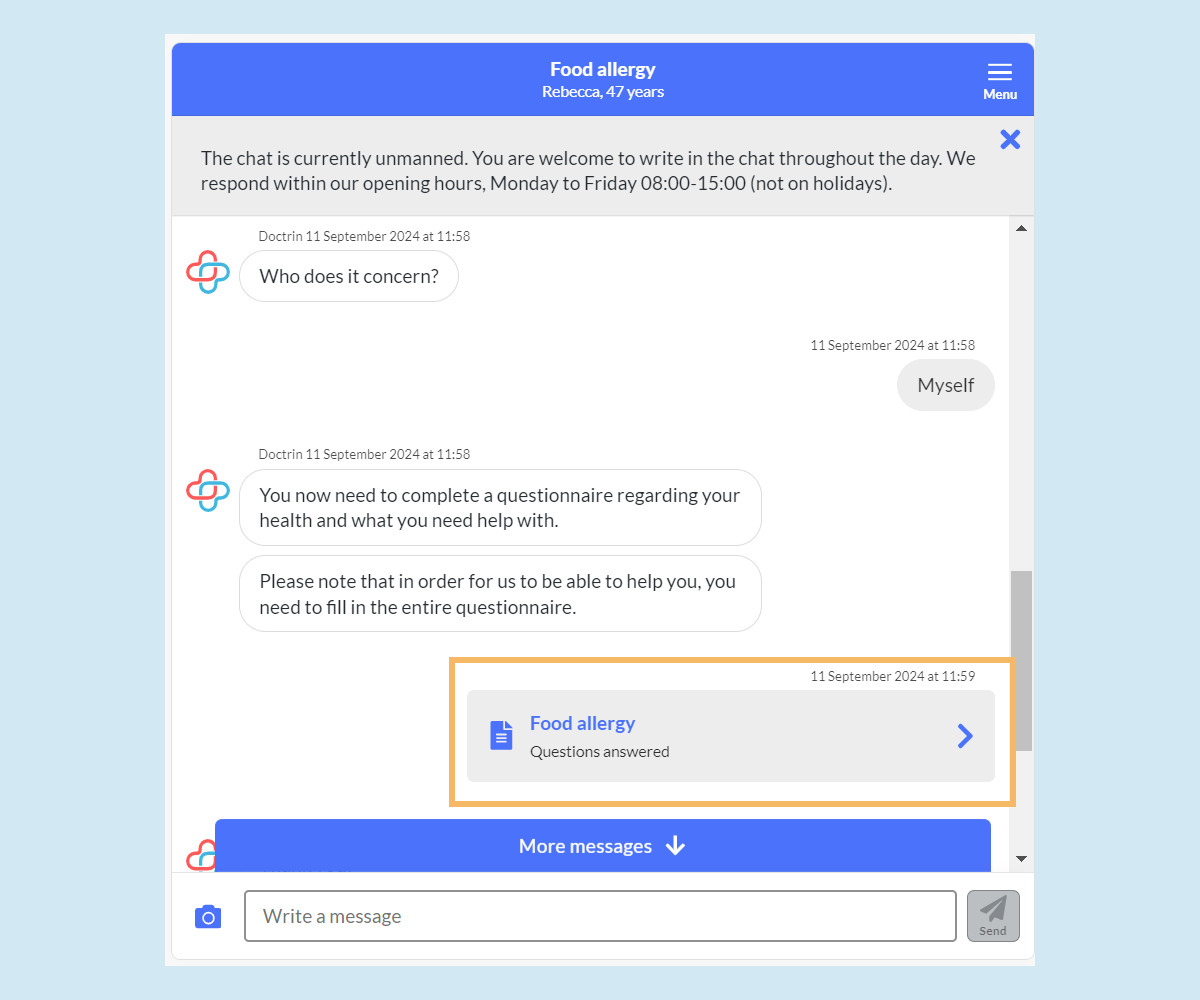
4.5 Supported devices and browsers
The interface for patients adapts to the resolution of the screen used (phone, tablet or desktop). The platform does not require any special hardware as the solution is completely browser based.

4.6.Evaluation of safety and performance
Doctrin regularly evaluates three areas that are crucial for the product’s safety and performance:
- The usability of medical history taking for patients
- The usability of the medical report
- Consistency between medical history taking and text strings in the medical report
Read the result from the 2024 evaluation here:
The usability of medical history taking
The usability of medical history taking was evaluated with 12 independent test participants in 2024. A tailored version of the System Usability Scale (SUS) was used. SUS is a standardised instrument for evaluating various aspects of usability in digital products. An acceptance level of at least 68 out of 100 points was applied (Lewis and Sauro, 2018).
All the test participants completed the test. The average usability rating was 82 out of 100 points, which is significantly higher than the acceptance level.
The usability of the medical report
The usability of the medical report was evaluated with 12 independent test participants from three different healthcare units in 2023. The participants represented various professions, including doctors, nurses, and physiotherapists. A tailored version of the System Usability Scale (SUS) was used.
SUS is a standardised instrument for evaluating various aspects of usability in digital products. An acceptance level of at least 68 out of 100 points was applied (Lewis and Sauro, 2018).
All test participants completed the test. The average usability rating was 81 out of 100 points, which is significantly higher than the acceptance level.
Consistency between medical history taking and text strings in the medical report
The medical report is composed of text strings that present patients’ responses. Text strings can be configured in a way that makes them misleading or incorrect. Therefore, Doctrin regularly conducts checks on text strings in the product. In the tests, an acceptance level of <0.1% is used for errors that could affect clinical decision-making, and <1% for errors that may impact quality but do not affect clinical decision-making.
Text strings with particularly high relevance from a risk perspective were selected, such as text strings for yes/no questions where an incorrect text string could provide contradictory information to the staff. A total of 15,699 text strings were manually reviewed. A total of 2 errors (0.01% of the total number of text strings) were found that could affect clinical decision-making. The errors were analysed for risk and assessed as having no impact on patient safety. Additionally, 25 other errors (0.16% of the total number of text strings), such as spelling mistakes, which were not considered to affect clinical decision-making, were identified.
All errors were immediately corrected.
Sources
Lewis, J. R., & Sauro, J. (2018). Item benchmarks for the System Usability Scale. Journal of Usability Studies, 13(3).
4.7.Basic manufacturer and medical device information
Manufacturer name |
Doctrin AB |
Manufacturer address |
Gävlegatan 22, 113 30 Stockholm, Sweden |
|
SRN |
SE-MF-000043089 |
Product trade name |
Doctrin Source |
Product name medical device |
Report Generating Service (RGS) |
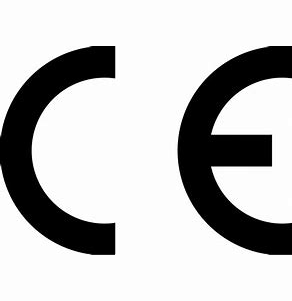 |
Contact
Do you have questions about a case in Doctrin?
Contact the clinic where you sought care.
Malfunctions in the product
In case of serious incidents or if you experience that the product is not functioning as expected, please report this to your healthcare provider for further evaluation.

